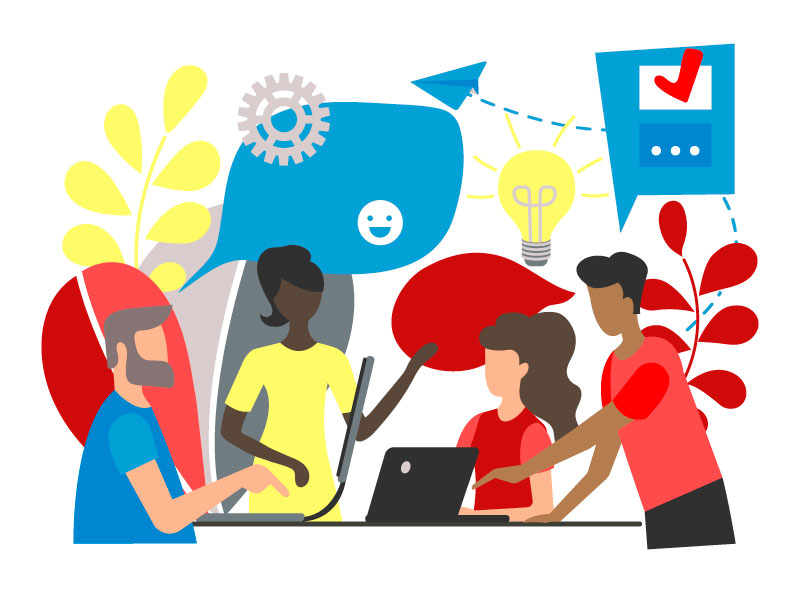At conferences, I sometimes wander into sessions without knowing the speaker or topic. This was the case during the 2025 Calgary Teacher’s Convention. (I wasn’t crashing the convention: I’m an educator as well as an editor.) I eschewed the session on my schedule and, by chance, ended up at a talk by Dr. Samra Zafar. In her talk, “The workplace of belonging,” she spoke about the connection between internal acceptance and external affirmation and how this creates communities essential for the safety of a diverse workspace.
I could have gone into any room in the immediate area, and yet I randomly chose the one that echoed ideas that have been circulating in my head: the need for affective communities as editors and as people.
Affective communities and editors
The term “affective community,” popularized through Dr. Leela Gandhi’s 2006 book Affective Communities, has deep roots in sociology and postcolonialism. However, at its simplest, an affective community is the coming together of people based on shared values and emotions, rather than external factors such as nationality. Unlike communities that define themselves in opposition to others (e.g., identifying with a political party), affective communities seek to uplift everyone within them.
How does this impact editors?
Fostering affective communities as editors can impact our mindsets, our work with clients and our relationships with other editors.
Editors need a community mindset
Remote work has broken down borders and flung open the door for more work, but it can be isolating. You may only meet your client once or twice over video. Most communication exists in emails and tracked changes.
But what if you shift your focus to community? There’s a mythologized view of an editor moving into an author’s house and acting as a harmonious extension in service of the book. Forget the impracticalities of this vision: the idea is worth considering. The shift here is away from “I am providing copy edits for this book” to “I am part of this book.”
In her lecture as part of the inaugural Alchemy Lecture, ’Aha Makhav poet Natalie Diaz explores the powerful preposition:
“Of as reciprocity. Of as a responsibility to tend and be tended. Of as toward the world, a practice of living for and with others, not alone but among.”
Seeing yourself of the process of a work’s creation is a powerful step to forming communities with clients and colleagues, and it’s a tool for combating isolation.
Editors work with people, not words
It is easy to get lost in the work and ignore the person behind the text. But what happens when our primary focus is uplifting, not simply correcting, a writer’s voice? We develop a better understanding of the writer as a person and a better understanding of their intentions in crafting the work. And if writers reciprocate and consider the editor as a person rather than a faceless spell-checker? It fosters trust, permitting the editor to make more recommendations that could greatly improve the work. (Sidenote: this is the human aspect to our work that AI, even at its best, cannot compete with.)
Whether it is through an initial meeting or over email, try to get to know the person before you get to know their work.
Editors benefit editors
This may seem obvious. We love to share our triumphs and trials for each others’ benefit. However, it can be easy to view other editors as competition, particularly for those of us in the earlier stages of our careers. This is counterintuitive. Collaboration benefits everyone.
By being part of an affective community, by working together as editors, we have the power to expand the editing profession. How can we expand our own editing practices to use our talents to advocate for positive change?
It is already happening.
In February 2025, I joined the livestream for the launch of the second edition of Gregory Younging’s Elements of Indigenous Style, edited by Warren Cariou. Coming together (in person and virtually) to celebrate this style guide reflected a community seeking to celebrate and advocate for Indigenous voices in the publishing space.
There is a push to encourage the Canadian government to adopt Editors Canada’s 2024 Professional Editing Standards (PES). This is not driven by personal or organizational profit, but a desire to say that we believe accessibility, conscious language, respect for the authenticity of an author’s voice and the many values in the PES are beneficial for all Canadians.
Your work as an individual editor is important: enhance it by connecting with editors to elevate common beliefs and unite your community.
Finding affective communities
Affective communities can be found anywhere. Invite a fellow editor out for coffee to share ideas. Seek out social media spaces (be careful, as not all are affective or effective).
I have found Discord to be a wonderful source for affective communities.
And, of course, there’s Editors Canada. Editors sharing their expertise and connecting via The Editors’ Weekly, l’Hebdomadaire des réviseurs, webinars or branch and twig initiatives builds community.
I have had the pleasure of working with a few Editors Canada committees that have greatly helped align my internal vision with my external environment, creating belonging and creating an affective community.
Where do you find community? Share in the comments below any resources and spaces that have increased your sense of belonging as an editor.
___
Previous post from Alex Benarzi: Editing with Vision Loss: Accessibility Tips
The Editors’ Weekly is the official blog of Editors Canada. Contact us.
Discover more from The Editors' Weekly
Subscribe to get the latest posts sent to your email.
